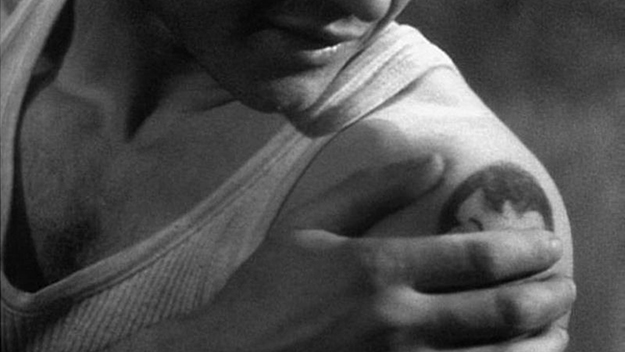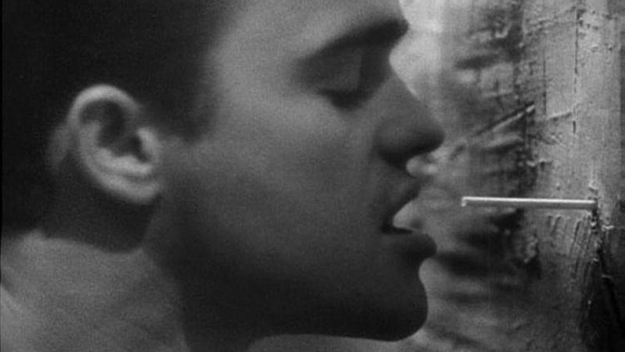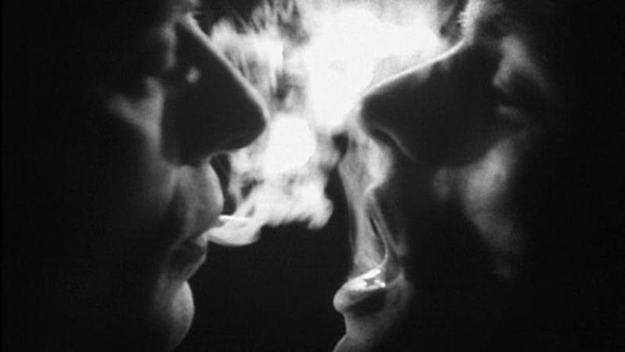Queer & Now & Then: 1950
In this biweekly column, I look back through a century of cinema for traces of queerness, whether in plain sight or under the surface. Read the introductory essay.
Two male arms protrude, up to the elbows, from the exterior windows of adjoining prison cells. One hand tries to swing a bouquet of flowers to the other, though it keeps eluding the second man’s grasp. As the history of gay love onscreen is largely one of thwarted or obscured desire, this image, among the very first in Jean Genet’s sui generis Un chant d’amour, contains an immense, representative power. Before being taken inside those lonely cells, we are already invited to feel the yearning for connection these two unseen men share. Yet as is also evident in his first novel, Our Lady of the Flowers, written behind bars, Genet was not what one would call a lovesick romantic, seeing the isolation of prison as a breeding ground for erotic transgression.
Un chant d’amour is the only film directed by the notorious multi-hyphenate, known as much for his begrimed, criminal past—he was an orphan raised in juvenile detention centers who grew up to become a petty thief and prostitute—as for the actual content of his novels, plays, essays, and poetry. This silent, black-and-white short from 1950 is remembered too often for the scandals and legal battles it incited and not enough for its artistry, for how much tenderness, fear, and sensuality it conveys without a single spoken word. It is awash in overt gay horniness, the likes of which, over the last century of film, have appeared as rarely as a ghost orchid. Yet the explicitness of its imagery has perhaps overwhelmed discussion of its supple construction. Though the film is steeped in symbolism (that eternally swinging flower bouquet), Genet’s film has no need to displace eroticism onto metaphorical objects: there’s a direct and literal sweating, heaving desperation with which the film’s principal men (two prisoners and one peeping guard) lust after one another, despite—or maybe because of—the cement walls that separate them.
By the time he embarked on what would be his first and last film, Genet, who had been freed from prison for the final time in 1944, had written five novels and two plays that had been publicly performed, composed multiple poems, and had pursued the company of other influential artists, writers, and philosophers in postwar Paris, including Jean-Paul Sartre, Jacques Derrida, Igor Stravinsky, Jean Marais, and Jean Cocteau. Another crucial figure for Genet at this point was future radical filmmaker Nico Papatakis, a leftist activist who had fled to France from Greece following political persecution. The two had a tumultuous on-again-off-again friendship, although Papatakis was so impressed with Genet’s 1947 play The Maids (which Papatakis would adapt into Les Abysses, a rattling howling wail of a film from 1963) that he agreed to collaborate on Genet’s first film, knowing full well that the proposed film, to be shot on 35mm on a budget of five-hundred thousand francs, would be first and foremost a work of homosexual eroticism.
Then working as manager of Parisian cabaret Le Rose Rouge, known for its politically radical performances and hangout for the Existentialists of the day, Papatakis would produce Un chant d’amour, as well as provide the shooting space for this clandestine, script-less project: Papatakis’s hotspot nightclub became Genet’s hothouse prison, the elaborate set built on the establishment’s upper floor. For the film’s late fantasy scenes of outdoor escape, Cocteau—who visited the set more than once—allowed access to shoot on his property in Milly-la-Forêt. And as cinematographer, Genet hired Jacques Natteau, who had worked as assistant camera on many films, including Jean Renoir’s Zola adaptation La bête humaine. Thus a film that one might expect to have been at best a dubious production maudit was actually, in these liberal-minded postwar Paris enclaves, a form of radical expression that many of Genet’s fellow artists believed was worth supporting—regardless of the fact that the film was unlikely to be shown in any commercial public setting, outside of private parties by interested collectors and porn houses.
The central object of desire is an unnamed, tank-topped prisoner played by Lucien Sénémaud—at the time Genet’s married lover and the muse of a 1946 poem by Genet that bears the same title as the film. We first see Lucien, hands in pockets, performing a seductive solitary dance, a kind of reverie of self-possession that seems to cast signals through the wall into the next cell. Fondling his own upper-arm tattoo, running a hand through his hair, Lucien is photographed as though a devilish angel, giving off pheromones so strong that it drives his sweatered, hairy-chested convict neighbor into paroxysms of carnal angst. (The second actor, like the others, is unidentified, though is now believed, according to Jane Giles in her 1991 book about Genet’s film, to have been played by a Tunisian-born barber and pimp from Montmartre.) In a startlingly erotic image, this second, older man delicately inserts a thin straw into a tiny hole in the cement wall between them, through which he blows cigarette smoke; on the other side Lucien ecstatically inhales.

Yet Un chant d’amour does not only visualize the pangs of lust between these two separated men—the desire is free-floating throughout the prison, and the film often weds itself to the voyeuristic gaze of one of the guards. From the first shot, in which the guard prowls the prison yard, the film is established as partly from his perspective. Peering through the shutters on each of the jail cell doors, he is served up a buffet of arousing exhibitionists, making for some of Genet’s most daring visual provocations: a nude man masturbating over his toilet; a dancer (played by Montmartre cabaret performer “Jeannot le Martiniquais”) thrusting his nearly naked body around his room before grinding his crotch into his bed; Lucien casting come-hither, lip-licking glances across the room and towards the camera, inviting us and the guard to take in an exposed armpit glistening with sweat, captured in fetishistic close-up; a quick flash of an erection, tapping against the cell wall of its own accord like a finger puppet. The sexually frustrated warden in effect becomes a peep-show patron, or, even more relatably, a reflection of us film viewers. When he turns from one of the doors, his hand is on his crotch.
Wrote Edmund White in his epochal biography of Genet: “He once said he felt he had been led toward prison because he suspected it was the most favorable place for homosexuality.” With the prison established as a kind of seminary for lust and erotomania, Genet dissolves the second half of Un chant d’amour into dreams and fantasy. The guard begins to visualize a sadomasochistic manifestation of his own sublimated passion, approaching the second prisoner and whipping him with his belt; he later stuffs a gun suggestively in his mouth—the specter of death intermingled with sex. Alongside these sexually violent daydreams are stylishly lit interiors, chiaroscuro compositions in which the guard imagines he’s fondling and sexually engaging with different men, shot as though emanating from some deep black void of the mind: nude bodies writhing in the dark, hands wrapped around a neck, two kissing lovers veiled by cigarette smoke, and later passing (what else?) a flower back and forth from one mouth to the other. The amorous prisoner on the receiving end of the guard’s punishment, meanwhile, imagines his own fantasy: a playful romantic idyll in the woods in which he presents Lucien with that long elusive bouquet of flowers—placed suggestively over his genitals. The guard and the prisoner, the empowered and the victimized, each long for sexual freedom, though as Genet shows, the meaning of liberation is relative.

Un chant d’amour’s screening patterns proved understandably mercurial. What might have been an official premiere at the Cinematheque française in 1954 became instead an occasion for a hastily censored version. The film had a scandalous comeback in 1964: activist and distributor Saul Landau filed a suit, backed by the ACLU, when police confiscated it from him after he had shown it to private groups throughout Berkeley, Santa Barbara, and San Francisco; and in New York, subversive cinema guru and Cinema 16 founder Jonas Mekas defiantly showed the banned film at the Writers’ Stage Theater, just one week after he was arrested on obscenity charges for showing Jack Smith’s queer landmark Flaming Creatures and the theater was raided. In his post-arrest statement, written for this very publication in winter of that year, Mekas writes of Genet’s film: “It is a work of art and like any work of art it is above obscenity and pornography, or, more correctly, above what the police understand as obscenity and pornography. Art exists on a higher spiritual, aesthetic and moral plane.” The U.S. Supreme Court would disagree: in 1967, following Landau’s drawn-out legal battles, a vote of 5-4 upheld the film as obscene. Though banned for years, the film is now occasionally screened—often in programs alongside homoerotic avant-garde shorts like Kenneth Anger’s Fireworks or Cocteau’s Blood of a Poet—and has been made accessible on the Internet. Even in a landscape of readily accessible pornography, the blatant carnality of Genet’s film can come as a shock.
Genet himself was famously not enamored of the film, though hardly because of its explicitness or controversy. According to White, he rejected it for being “too bucolic and not sufficiently violent.” Yet it’s the surprising sensitivity in the way Genet presents the derangement of human desire that makes the film such a dark tonic. In the film’s ambiguous climax, the prisoners’ liberation becomes poignant, though never sentimental. Suddenly the dream shifts, and we see the older prisoner carrying Lucien through the forest, slung over his shoulder. He lays his younger lover down on the ground, as though he’s sick or incapacitated. Just as homosexual love blossoms in the dark, perhaps in Genet’s world it withers in the sunlight.
Michael Koresky is the Director of Editorial and Creative Strategy at Film Society of Lincoln Center; the co-founder and co-editor of Reverse Shot; a frequent contributor to The Criterion Collection; and the author of the book Terence Davies, published by University of Illinois Press.







